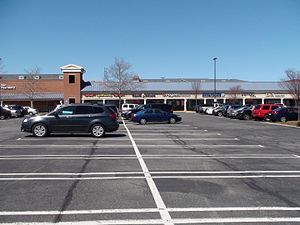Kentlands, Maryland
| Kentlands, Maryland | ||||||||
|---|---|---|---|---|---|---|---|---|
| Neighborhood of Gaithersburg | ||||||||
From left to right, clockwise from top to bottom: A Kentlands K-Mart store in March 2015, a Kentlands Giant grocery store in March 2015, downtown Kentlands in March 2015, Kentlands' main street in March 2008, Kentlands townhouses in March 2008, and Kentlands houses in March 2008.
|
||||||||
| Coordinates: 39°07′07″N 77°14′09″W / 39.11861°N 77.23583°WCoordinates: 39°07′07″N 77°14′09″W / 39.11861°N 77.23583°W | ||||||||
| Country |
|
|||||||
| State |
|
|||||||
| County |
|
|||||||
| City |
|
|||||||
| Settled | 1723 | |||||||
| Founded | 1988 | |||||||
| Named for | Otis Beall Kent | |||||||
Kentlands is a neighborhood of the U.S. city of Gaithersburg, Maryland.
Kentlands was one of the first attempts to develop a community using Traditional Neighborhood Design planning techniques (also known as neo-traditional new town planning) that are now generally referred to under the rubric of the New Urbanism. The New Urbanism is the concept of building from scratch a walkable, mixed-use city neighborhood or new town in order to provide an attractive alternative to the spread out, automobile-centric, subdivisions common to post-World War II American suburbia. Kentlands is built around a farmstead previously owned by Otis Beall Kent.
The development, begun in 1988, contains buildings from the original Kentlands farm, many varieties of residences, a "downtown" commercial district, open space including protected natural areas and pocket parks, and civic uses including schools, a church, clubhouse, pool, tennis and basketball courts, catering facility, and an arts center.
Kentlands is built on a former farm estate that had its origins in a 1723 land grant to Joseph West. In the mid-18th century, Henry Clagett, a prosperous farmer, acquired much of this land for his holdings. When Clagett died in 1777, several sections of this property passed to his son, Joseph.
The Tschiffely family began to farm the land in 1852, when Frederick A. Tschiffely, who owned a prominent wholesale pharmaceutical business in Washington, D.C., purchased more than 200 acres (0.81 km2) of land from the Clagett heirs. In 1900, his son, also named Frederick A. Tschiffely, built the impressive brick mansion, barn, gatehouse, overseer's house, greenhouse and chicken coop that gave the property the nickname of "The Bricks". The family called their estate Wheatlands, after the wheat that was grown on the farm, and raised their eight children in the mansion. Mr. Tschiffely was the largest wholesale pharmaceutical distributor in the Washington area, and owner of Washington's best-known pharmacy. His daily commute to Washington began with a horse and buggy drive to the Gaithersburg train station.
In 1942, the Tschiffely family sold the land to Otis Beall Kent. Kent, a wealthy tax lawyer, renamed the land Kentlands Farm, and he set about to create a gentleman's estate and wildlife sanctuary. In the 1960s, part of the land was given to the Izaak Walton League and the National Geographic Society with conditions of maintaining much of the land as a wildlife sanctuary. Mr. Kent bequeathed the remainder of the property to his adopted daughter, Helene Danger Kent. That portion was annexed into the city of Gaithersburg and was sold in 1988 to the town creator, Joe Alfandre.
...
Wikipedia






